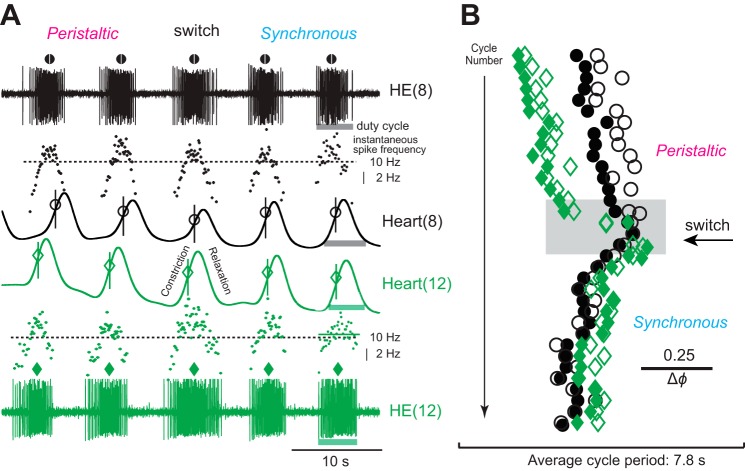Fig. 7.
Extracellular recordings from 2 ipsilateral heart motor neurons and movement recordings of the corresponding heart segments in vivo (minimally dissected leeches). A: 5 bursts of the heart motor neurons in segments 8 [HE(8), black] and 12 [HE(12), green] across a switch from the peristaltic to the synchronous mode. Symbols above each motor neuron burst denote its middle spike [HE(8), circle; HE(12), diamond]. Instantaneous spike frequency is shown for each burst [HE(8), black dots; HE(12), green dots]. Dotted horizontal lines correspond to 10 Hz. Movement signals in heart(8) (black) are shown below the appropriate motor neuron burst and those of heart(12) (green) above. The MRR of movement is indicated for each beat [heart(8), circle; heart(12), diamond; vertical lines added for visual clarity]. Light-colored bars indicate the duty cycles for the motor neurons and for the heart segments (segment 8, gray; segment 12, green). In the peristaltic mode, the HE(12) heart motor neuron fires before the HE(8) heart motor neuron and heart(12) constricts before heart(8), while both motor neurons and both hearts are active almost simultaneously in the synchronous mode. Note that the MRR of movement coincides with the peak spike frequency of the corresponding heart motor neuron. Note also that hearts may begin to relax even while the motor neuron is still firing (e.g., in segment 12). B: actogram shows the phase relations of the middle spike of the motor neurons and the MRR of movement over many beat cycles across a switch from the peristaltic to the synchronous coordination mode (colors and symbols as in A). Note the cycle-to-cycle variability in the phase relation between the middle spike of a heart motor neuron and the MRR of movement in the corresponding heart segment. Note also that the intersegmental phase differences between the 2 motor neurons and those between the hearts of segments 8 and 12 vary. The gray box outlines the section of the recording shown in A.

